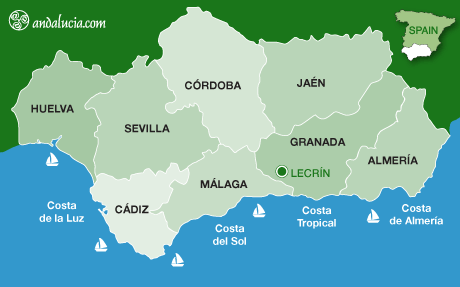Lecrin
Lecrin is the town which was named after the comarca (area) Valle de Lecrin (Lecrin Valley) in which is is located. As a municipality Lecrin was only formed in the 1970s. It was combined with six older villages - Mondújar, Talará, Béznar, Acequias, Chite and Murchas to form the - have been around for much longer.
In the area of Mondújar, the most interesting feaures from a historical and artistic point of view are the Iglesia de San Juan Bautista and the Termas Romanas. The church dates from the 16th century and inside there is a neoclassical altar and various sculptures including carvings of San Juan Bautista, la Virgen del Rosario and Nuestro Padre Jesús. The Roman thermal baths also located here date from between the late first century B.C. and the early fourth century AD. Be sure to check out the hot baths and the semicircular swimming pool.
In Talará, which was originally a neighbourhood of Mondújar, it is worth visiting the three churches. The Ermita del Santo Cristo and Iglesia de la Purísima Concepción were both built in the 18th century, whilst the Iglesia Parroquial de la Inmaculada Concepción was built in the 16th century. This church has a beautiful Mudejar coffered ceiling.
Béznar is the southernmost area in the municipality and also the lowest. Visitors should be sure to see the reservoir of the same name, beneath whose waters lie the remains of one of the old neighbourhoods. The Iglesia de San Antón, constructed in the 16th century, has an amazing Gothic and Mudejar facade - try and take a look!
Between the bed of the río Torrente, el Barranco del Pleito and Cerro Gordo you'll find the highest area in Lecrín: Acequias. This village has an old mill that has now been converted into a museum, and is part of the Molinos del Valle de Lecrín (mills of the Valley of Lecrín) tourist route. Visitors can follow this route in various ways; walking, horse riding or mountain biking. The Iglesia de San Antón, a Renaissance church with one nave was constructed in the mid-16th century, and has a Moorish coffered ceiling and a multicoloured altarpiece.
In Chite, visitors should take a walk through the streets of the Alto and Bajo neighbourhoods, taking in Morisco-style houses and mansions from the 19th century with beautifully kept gardens. Also worth a visit is the Iglesia de la Inmaculada, originally built in the mid-16th century and restored at the beginning of the 17th. Inside, there is a Moorish coffered ceiling and paintings such as one of the Virgin and Christ.
Last of the districts of Lecrin is the village of Murchas, with the Iglesia del Salvador, constructed in the 16th century, and the Acequia de Arcos.
GASTRONOMY
The Lecrinense gastronomy focuses on the locally-grown oranges and lemons, as well as sugar cane, which residents make into traditional sugar cane sweets, using one of the oldest recipes in the area.
FIESTAS
Each different area of Lecrín has its own fiestas and traditions. In January, Acequias celebrates the Fiesta de San Antón with religious acts, festivals and fireworks. Similar celebrations take place in Chite in June, when they celebrate the Fiestas de San Segundo. Fiestas in honour of la Virgen de los Desamparados and Santa Lucía are held in January in Murchas. Finally, in Talará, December brings the fiestas in honour of la Inmaculada Concepción and el Cristo de Zapato.
DIRECTIONS
Lecrín is 35km from Granada city. Take the A-44 (direction Armilla-Motril), and leave at exit 160 for the centre of Mondújar.
